|
Have a safe day!
Thursday, Feb. 13
11 a.m.
Intensity Frontier Seminar Series -
WH8XO
Speaker: Sam Zeller, Fermilab
Title: INT Workshop INT-13-54W Review: Neutrino-Nucleus Interactions for Current and Next Generation Neutrino Oscillation Experiments
11 a.m.
Computing Techniques Seminar -
WH7XO
Speaker: Martin Purschke, Brookhaven National Laboratory
Title: PET Imaging Devices Developed at the Brookhaven National Laboratory
1:30 p.m.
Special Seminar - Curia II
Speakers: Cynthia Robinson, Jeff Margolis, Michael Cooke - AAAS
Title: AAAS Science and Technology Policy Fellowships Informational Session
2:30 p.m.
Theoretical Physics Seminar -
Curia II
Speaker: David Sanford, Caltech
Title: Simplified Models of Mixed Dark Matter
3 p.m.
LHC Physics Center Topic of the Week Seminar - WH11NE
Speaker: Steven Worm, Rutherford Appleton Laboratory
Title: The Search for Dark Matter at the LHC
3:30 p.m.
DIRECTOR'S COFFEE BREAK - 2nd Flr X-Over
Friday, Feb. 14
3:30 p.m.
DIRECTOR'S COFFEE BREAK - 2nd Flr X-Over
4 p.m.
Joint Experimental-Theoretical Physics Seminar - One West
Speaker: Oliver Gutsche, Fermilab
Title: Recent Top Pair Asymmetry Measurements at CMS
Click here for NALCAL,
a weekly calendar with links to additional information.
Ongoing and upcoming conferences at Fermilab |
|
Thursday, Feb. 13
- Breakfast: Canadian bacon, egg and cheese Texas toast
- Breakfast: Mexican omelet
- Steak soft tacos
- Smart cuisine: spinach and jack cheese enchiladas
- Kielbasa and kraut
- Grilled vegetable sandwich
- Sweet and sour chicken
- Beef barley soup
- Chef's choice soup
- Assorted pizza by the slice
Wilson Hall Cafe menu |
|
Friday, Feb. 14
Dinner
- Potato, bacon and gruyere souffle
- Surf and turf (steak and lobster)
- Mushroom risotto
- Chocolate fondue
Wednesday, Feb. 19
Lunch
- Cheese fondue
- Marinated vegetables
- Gingered pear crisp
Chez Leon menu
Call x3524 to make your reservation.
|
|
AAAS Science and Technology seminar - today at 1:30 p.m.
Today three speakers will give a special seminar on how you can gain first-hand experience in establishing and implementing science policy. The seminar takes place at 1:30 p.m. in Curia II.
Director of AAAS Science and Technology Fellowships Cynthia Robinson, Managing Director of the Illinois Science and Technology Coalition Jeff Margolis, and DOE 2013-14 Executive Branch Fellow Mike Cooke will discuss AAAS Science and Technology Policy Fellowships.
Fellows bring a common interest in learning about science policy and a willingness to apply their training in new arenas. They serve in year-long assignments in the three branches of government in the Washington, D.C., region.
|
Hundreds of supernovae seen in first season of Dark Energy Survey
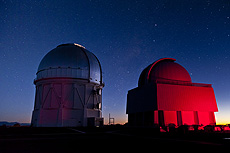 |
| Scientists on the Dark Energy Survey survey the southern sky using the Dark Energy Camera in Chile. Photo: Reidar Hahn |
On Feb. 9, Alex Drlica-Wagner and Steve Kent from Fermilab spent the night on a remote mountain top in Chile, carrying out the last observing run for the first of five seasons of the Dark Energy Survey. Using the Dark Energy Camera on the Blanco 4-meter telescope at Cerro Tololo Inter-American Observatory, DES completed 105 nights of data taking that started back on Aug. 31, 2013. In its first season, DES accumulated nearly 14,000 high-quality images, surveyed about 5 percent of the sky and discovered hundreds of supernovae, all in the quest to understand why the expansion of the universe is speeding up.
|
Anne Schukraft earns German Physical Society's Hertha Sponer Prize
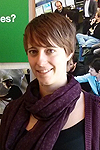 |
|
Anne Schukraft
|
In November the German Physical Society awarded Fermilab postdoc Anne Schukraft the 2014 Hertha Sponer Prize for her thesis work on the IceCube neutrino experiment. She will accept the award at a ceremony in March.
Established in 2002, the prize is awarded to one female scientist per year for outstanding contributions to physics.
Schukraft's thesis was an analysis of IceCube data taken from May 2009 to May 2010 to search for an extraterrestrial neutrino flux in a specific channel. The analysis also delivered an estimate of the atmospheric neutrino background, which became valuable in later searches with the completed detector, which for the first time found evidence for an extraterrestrial flux.
|
Trailing in the snow
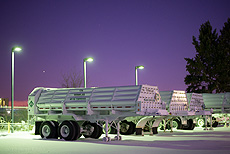 |
| Fermilab's helium trailers, located behind the Central Helium Liquefier off Road C, stand quietly on the snow-covered pavement. Photo: Steve Krave, TD |
|
Viewpoint: Neutrino experiments come closer to seeing CP violation
From Physics, Feb. 10, 2014
Charge-parity (CP) violation — evidence that the laws of physics are different for particles and antiparticles — is often invoked as a "must" to explain why we observe more matter than antimatter in the universe. But the CP violation observed in interactions involving quarks is insufficient to explain this asymmetry. As a result, many theorists are looking toward leptons — and, specifically, neutrinos — for additional sources of CP violation. Researchers running the Tokai to Kamioka (T2K) experiment — a particle physics experiment at the Japan Proton Accelerator Research Complex (J-PARC) — have now made an important contribution toward the search for CP violation in neutrinos. Writing in Physical Review Letters, the T2K collaboration reports the strongest evidence to date for the appearance of electron neutrinos from a pure muon neutrino beam. Their measurement allows them to determine a fundamental parameter of the standard model of particle physics, called θ13, which can in turn be used to make an early estimate of CP violation in neutrinos. Although this estimate has a large uncertainty, it will serve as a guide to future, more definitive neutrino experiments that are directly sensitive to CP violation.
Read more
|
Future colliders may dwarf today's largest atom smasher
From LiveScience, Feb. 11, 2014
LONDON — So, physicists have found the Higgs boson. What next?
It took three years for the world's most powerful particle accelerator, the Large Hadron Collider (LHC), to spot the elusive Higgs boson particle, which is thought to explain how other particles get their mass.
It took the international science lab CERN much longer, though, to build the machine beneath the mountains straddling France and Switzerland — nearly two decades, and at a cost of billions of dollars. There, protons are blasted through the 17-mile-long (27 kilometers) ring, where they crash into each other, and the resulting energy is converted to new and sometimes exotic particles.
However, if scientists want to look for new physics discoveries beyond the Higgs boson, in the form of new exotic particles and interactions, even the Large Hadron Collider may not be enough, said Terry Wyatt, a physicist at the University of Manchester who works on the LHC's ATLAS detector, one of seven particle-detector experiments conducted at CERN.
Read more
|
|
Six measurements of top quark pair production
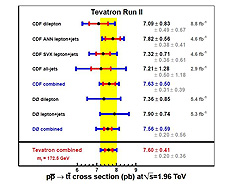 |
| The six input σ{tt } measurement from the CDF and DZero experiments, along with the CDF-only and DZero-only combination results and their combination for the Tevatron result. |
Fermilab Today has recently reported on several combined measurements. Today we look closely at one of them: the production cross section of a top quark and antiquark by a collision of a proton beam with an antiproton beam, where the energy in the center-of-mass frame is 1.96 TeV.
The aim of combining six different measurements from CDF and DZero is to make the measurement as close as possible to the true value and to have the best possible precision. The results are summarized in the above table. We see that there is very good agreement between CDF (7.63 ± 0.50 picobarns) and DZero (7.56 ± 0.59 picobarns). The combined measurement of 7.60 ± 0.41 pb is also in good agreement with the Standard Model expectation of 7.35 +0.28/-0.33 pb. Here, the production cross section is quoted for top quark mass of 172.5 GeV/c2.
The measurement is difficult for several reasons, yet scientists have achieved a precision of about 5 percent. The main problem was that only one in about 10 billion collisions produced a top quark pair. The data for Tevatron Run II was taken over a long time period from 2002 to 2011, and thus the equipment had to perform essentially perfectly for this time period. Thanks to the Accelerator Division, the instantaneous luminosity of the beams increased
over the years with a peak value of 4x1032 cm-2s-1 in April 2010. This is 400 times the original Tevatron design luminosity.
A top quark almost always decays into a W boson and a b jet. The W can decay into a charged lepton and a neutrino or into two jets. Thus for top quark pair production there are, in principle, three different decay modes: two b jets and either two charged leptons and two neutrinos (dilepton); one lepton, one neutrino and two jets (lepton+jets); or four jets (all jets).
CDF reports two measurements in the best mode for measuring top quark pair production, the lepton+jets mode. The first method (LJ-ANN) requires events with at least three jets and applies an artificial neural network to distinguish the signal from the background. The second method (LJ-SVX) uses a subsample of these events, ones that have at least one b jet, which reduces the dominant W+jet background substantially.
The DZero measurement proceeds by selecting events with at least three jets and splitting them into many subsamples according to the total number of jets and the number of identified b jets. Scientists used a sophisticated statistical method to separate the signal from the background in the background-dominated subsamples.
It is important to note that the systematic uncertainty from the luminosity is reduced in the CDF lepton+jets measurements by simultaneously measuring the top quark pair
and the cross section for the production of a different particle, the Z boson. This method takes advantage of the smaller theoretical uncertainty for Z boson production. Future measurements with the fully integrated luminosity can also use this technique to achieve even better precision and accuracy.
Learn more
—edited by Andy Beretvas
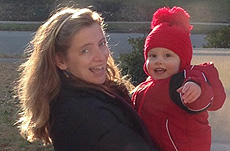 |
| This CDF analysis was done by Evelyn Thomson (University of Pennsylvania).
|
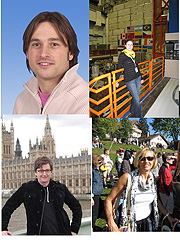 |
| These DZero members contributed to this analysis. Top row, from left: Frederic Deliot (CEA, Saclay, France) and Yvonne Peters (The University of Manchester, UK, and DESY, Germany). Bottom row, from left: Christian Schwanenberger (The University of Manchester, UK) and Lisa Shabalina (Georg-August-Universtat Gottingen, Germany). |
|
|